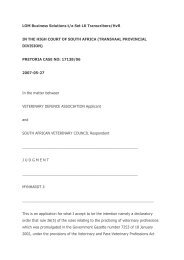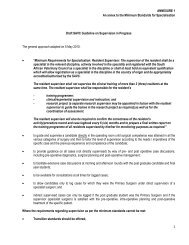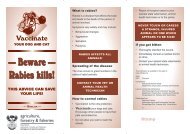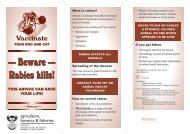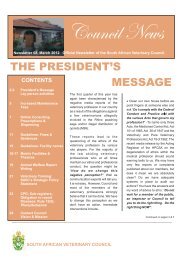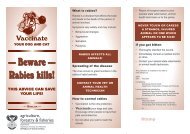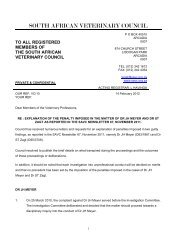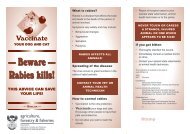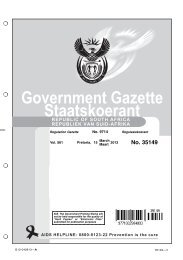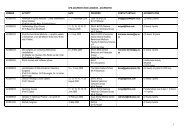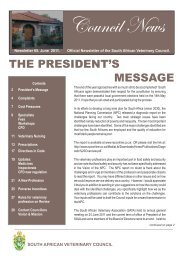Rabies Guide 2010.pdf - the South African Veterinary Council
Rabies Guide 2010.pdf - the South African Veterinary Council
Rabies Guide 2010.pdf - the South African Veterinary Council
You also want an ePaper? Increase the reach of your titles
YUMPU automatically turns print PDFs into web optimized ePapers that Google loves.
less labour-intensive than central-point vaccination.<br />
Education of communities before embarking on this<br />
course of action is imperative.<br />
Key factors which influence<br />
success<br />
Key factors that influence <strong>the</strong> success of control<br />
campaigns include: accurate epidemiological<br />
information, aggressive marketing, careful planning,<br />
thorough logistical preparation, intersectoral<br />
cooperation and enthusiasm. 155<br />
Ideally human and dog census figures should be<br />
obtained. This may require a separate local survey.<br />
Historical information of human and animal rabies<br />
cases toge<strong>the</strong>r with previous vaccination records for<br />
<strong>the</strong> outbreak areas are integral to <strong>the</strong> success of <strong>the</strong><br />
entire venture. Appropriate maps indicating roads,<br />
population distribution, schools, clinics, community<br />
centres and o<strong>the</strong>r key community meeting points<br />
allow efficient planning of <strong>the</strong> campaign. 156<br />
Cultural perceptions of local communities, level of<br />
education, attitude towards previous campaigns and<br />
awareness of rabies should be borne in mind. Cost<br />
analyses of previous campaigns and control strategies<br />
can be used to advocate for funding.<br />
Aggressive marketing is probably <strong>the</strong> most important<br />
prerequisite for ensuring adequate coverage. This<br />
should aim at maximum mobilisation of communities<br />
by utilising all appropriate media within available<br />
resources. Television, radio, newspapers, water and<br />
electricity accounts, schools, tribal and district<br />
authorities, health authorities and clinics, churches,<br />
dip-tanks, pamphlets, posters, loudspeakers, and word<br />
of mouth are all avenues that have been successfully<br />
utilised in <strong>South</strong> Africa. Innovative measures such as<br />
advertisements placed on taxis and inserts on audio<br />
tapes distributed via <strong>the</strong> minibus association have also<br />
improved coverage. Small incentives and inexpensive<br />
gifts, such as peak hats and stickers with rabies<br />
prevention messages, have heightened awareness and<br />
promoted enthusiastic participation in vaccination<br />
campaigns.<br />
It is important to remember that communication<br />
and marketing channels differ between communities,<br />
and it is <strong>the</strong>refore essential to identify and utilise <strong>the</strong><br />
most locally appropriate means. The horrific nature<br />
of rabies results in extensive coverage being provided<br />
by various media organisations and local and district<br />
authorities, usually free of charge.<br />
Community needs and circumstances should always<br />
influence decisions on <strong>the</strong> timing and location<br />
of vaccination campaigns. A tailored strategy for<br />
each community must be well planned in advance<br />
of a campaign. Vaccination campaigns should be<br />
conducted at a time when people are available to<br />
bring <strong>the</strong>ir dogs. This is generally before or after<br />
normal working hours in affluent societies, in <strong>the</strong><br />
afternoon in areas where schoolchildren are expected<br />
to bring dogs, and during weekends, particularly<br />
Saturday mornings, or school holidays in both urban<br />
and rural areas.<br />
The choice of venue should be carefully considered.<br />
In urban areas a large open space that is well lit and<br />
preferably near shops, schools, community centres or<br />
a post office in an area of high population density,<br />
generally yields <strong>the</strong> best results.<br />
Distances between vaccination points should not<br />
exceed 3 to 4 km. Surveys indicate that in communities<br />
lacking transport, <strong>the</strong> majority of <strong>the</strong> community will<br />
seldom walk, drag or carry <strong>the</strong>ir dogs beyond 2 km<br />
to be vaccinated. Where annual campaigns are held,<br />
rainfall pattern, temperature and wea<strong>the</strong>r conditions<br />
should be considered if high vaccination coverage is<br />
to be obtained.<br />
Ensure that adequate supplies of vaccine, certificates,<br />
and clean sterile syringes and needles are available.<br />
Sufficient tables, chairs and assistants are vital for a<br />
smooth-running and efficient campaign. Ensure that<br />
all administrative material and equipment are available<br />
before initiating <strong>the</strong> campaign. These include <strong>the</strong><br />
items on <strong>the</strong> campaign equipment checklist (Table<br />
13).<br />
The type of operation chosen will determine <strong>the</strong><br />
scale of interdepartmental liaison and intersectoral<br />
collaboration between <strong>the</strong> Departments of Health,<br />
Justice, Education and <strong>the</strong> <strong>South</strong> <strong>African</strong> Police<br />
Service required. It is important that tribal authorities,<br />
organised agriculture, local government, private<br />
veterinarians and welfare organisations must be<br />
involved to ensure success.<br />
The success of any disease control programme is<br />
directly related to <strong>the</strong> enthusiasm and commitment<br />
of team leaders and members. The decision on<br />
58



